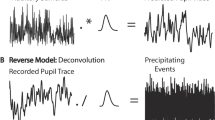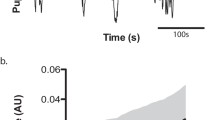Abstract
Two methods to accurately determine the moment of pupil constriction onset are discussed. For data sampled at a high rate (≈200 Hz) pupil velocity deviations from zero can simply be used, giving a satisfactory inaccuracy of about 5 ms. For data sampled at a low rate (<50 Hz), e.g. using a TV pupillometer, curve-fitting can be applied. It is demonstrated that curve-fitting, based on a second-order mathematical model, preceded by a linear trend, can result in an inaccuracy of less than 5 ms. Both methods give latencies independent of signal amplitude. This implies that a pupillometer yielding a relative measurement of the pupil area can be used for the detection of pupil constriction latencies. Furthermore it is demonstrated that the averaging of pupil constrictions results in an advanced moment of onset. Where latency differences of less than 25 ms are concerned, raw pupil data should therefore not be averaged.
Similar content being viewed by others
References
Alexandridis, E., Argyropoulos, T. andKrastel, H. (1981) The latent period of the pupil light reflex in lesions of the optic nerve.Ophthalmologica,182, 211–217.
Alexandridis, E., Gartner, R. L., Krastel, H. andHagenlocher, H. U. (1982) Latenz der Pupillenlichtreflexe und des VECP im Verlauf der retro-bulbaren Neuritis.Fortschr. Ophthalmol.,79, 356–357.
Alpern, M., McCready, D. W. andBarr, L. (1963) The dependance of the photo-pupil response on flash duration and intensity.J. Gen. Physiol.,47, 265–278.
Argyropoulos, TR., Krastel, H. andAlexandridis, E. (1980) Latenz der Pupillenlichtreflexe bei Erkrankungen des Sehnerven.Ber. Dtsch. Ophthalmol. Ges.,77, 373–377.
Beaumont, S. M., Harris, J. P., Leendertz, J. A. andPhillipson, O. T. (1987) The pupillary light reflex in mild Parkinson's disease.Clin. Vision Sci.,2, 123–129.
Borgmann, H. (1972a) Grundlagen fur eine klinische Pupillographie. III. Abhangigkeit der Parameter der Lichtreaktion vom lebensalter.Albr. v. Gr. Arch. klin. exp. Ophthalmol.,185, 1–10.
Borgmann, H. (1972b) Grundlagen fur eine klinische Pupillographie. IV. Abhangigkeit der Pupillenweite und der Lichtreaction von Geschlecht, Irisfarbe und Refraction.Albr. v. Gr. Arch. klin. exp. Ophthalmol.,185, 11–21.
Bos, J. E. (1988) Clinical quantitative pupillometry: the latency of pupillary constriction as measured with the IRIS system; preliminary results.Neuro-ophthalmol.,8, 299–305.
Bos, J. E., Fock, J. M., Reulen, J. P. H. andvan Lith, G. H. M. (1990) Pupil constriction and visual evoked potential latency in optic neuritis.Neuro-ophthalmology,10, 187–196.
Drischel, H. (1957) Untersuchungen uber die Dynamik des Lichtreflexes der menschlichen Pupille. I. Der normale Reflexablauf nach kurzdauernder Belichtung und seine Variabilitat.Pflug. Arch. Ges. Physiol.,264, 145–168.
Ellis, C. J. K. (1979) The afferent pupillary defect in acute optic neuritis.J. Neurol. Neurosurg. Psychiatry,42, 1008–1017.
Feinberg, R. andPodolak, E. (1965) Latency of pupillary reflex to light stimulation and its relationship to aging. InBehavior, Aging and the nervous system,Welford A. T., Birren J. E. andThomas C. C. (eds), Springfield, Ill., 326–339.
Friedmann, S. A., Feinberg, R., Podolak, E. andBedell, R. H. S. (1967) Pupillary abnormalities in diabetic neuropathy.Ann. Intern. Med.,67, 977–983.
Kristek, A. (1966) Die klinische Infrarotpupillographie.Acta Univ. Palackianae Olomucencis,40, 389–445.
Lee, R. E., Cohen, G. H. andBoynton, R. M. (1969) Latency variation in human pupil contraction due to stimulus luminance and/or adaptation level.J. Opt. Soc. Am.,59, 97–103.
Namba, K., Utsumi, T. andKitazawa, A. (1980) Diabetes mellitus and the pupil; a preliminary report.Nippon Ganka Gakkai Zasshi,84, 398–405.
Pfeifer, M. A., Cook, C., Brodsky, J., Tice, D., Parrish, D., Reeman, A., Halter, J. B. andPorte, D. (1982) Quantitative evaluation of sympathetic and parasympathetic control of iris function.Diabetes Care,5, 518–529.
Pfeifer, M. A., Weinberg, C. R., Cook, D. L., Reenan, A., Halter, J. B., Ensinck, J. W. andPorte, D. (1984) Autonomic neutral dysfunction in recently diagnosed diabetic subjects.Diabetes Care,7, 447–453.
Reulen, J. P. H., Marcus, J. T., van Gilst, M. J., Koops, D., Bos, J. E., Tiesinga, G., de Vries, F. R. andBoshuizen, K. (1988) Stimulation and recording of dynamic pupillary reflex: the IRIS technique. Part 2.Med. & Biol. Eng. & Comp.,26, 27–32.
Semmlow, J., Hansmann, D. andStark, L. (1975) Variation in pupillomotor responsiveness with mean pupil size.Vis. Res.,15, 85–90.
Stark, L. W. andShermann, P. M. (1957) A servoanalytic study of consensual pupil reflex to light.J. Neurophysiol.,20, 17–26.
Thompson, H. S. (1966) Afferent pupillary defects.Am. J. Ophthalmol.,62, 860–873.
Usui, S. (1974) Functional organization of the human pupillary light reflex system. Ph.D. thesis, UC Berkeley, 86.
Author information
Authors and Affiliations
Rights and permissions
About this article
Cite this article
Bos, J.E. Detection of the pupil constriction latency. Med. Biol. Eng. Comput. 29, 529–534 (1991). https://doi.org/10.1007/BF02442326
Received:
Accepted:
Issue Date:
DOI: https://doi.org/10.1007/BF02442326




